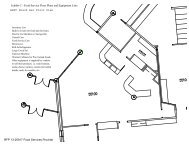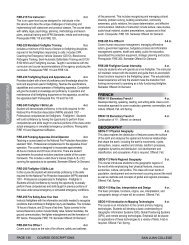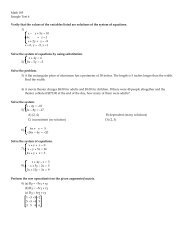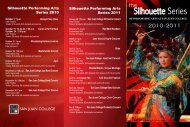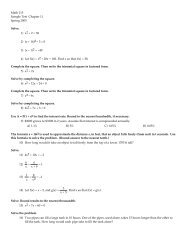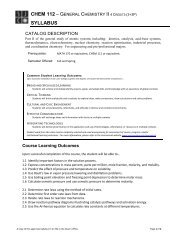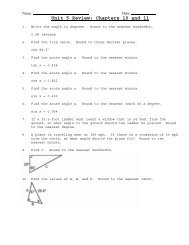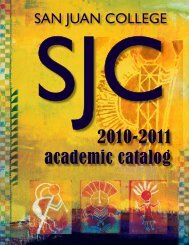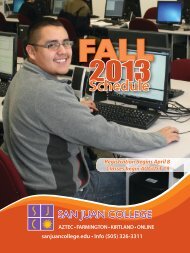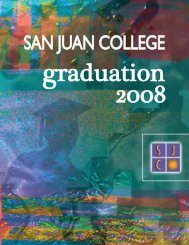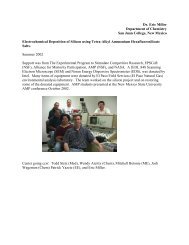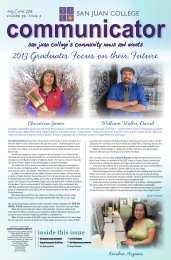AQIP 2007 Systems Portfolio - San Juan College
AQIP 2007 Systems Portfolio - San Juan College
AQIP 2007 Systems Portfolio - San Juan College
You also want an ePaper? Increase the reach of your titles
YUMPU automatically turns print PDFs into web optimized ePapers that Google loves.
<strong>San</strong> <strong>Juan</strong> <strong>College</strong> – <strong>AQIP</strong> <strong>Systems</strong> <strong>Portfolio</strong> – November <strong>2007</strong>• Artifacts are collected only from those studentswho give written permission and are nearingprogram completion (50+ credits—as identifiedby Institutional Research).• Instructor provides artifacts to AssessmentCommittee (or School/department assessmentteams) for assessment using CLSO rubric(s).• Record results using the 5 CSLO rubrics and asummary sheet• Results will be reported back to all faculty, aswell as to deans and the vice president forlearning, to affirm outcomes and consider how toimprove learning.• Results will not be used to evaluate individualstudents or faculty members, only to informdecisions regarding curriculum improvement andprogram design.Committed to refining and perfecting our assessmentprocesses, SJC is participating for the next four years,beginning in June <strong>2007</strong>, in the Higher LearningCommission’s Academy for the Assessment ofStudent Learning. The Assessment Committee ischarged with broadening the scope of assessment atSJC and developing meaningful performancemeasures at the school and institutional level (see 1I2for detailed charge).1P12 SJC obtains information on how well preparedgraduates are for employment through the followingfeedback mechanisms: course and instructorevaluations; graduate placement and salary surveys;employer surveys; program advisory committees;licensure and certification exam results and stateperformance indicators (see Category 1 Results).The results of these surveys are analyzed and sharedwith program directors to use in planning programmodifications.1P13 The direct measures of student performanceand achievement that SJC collects and analyzesregularly include pass rates in individual courses,retention and graduation rates in each academicprogram, percent of New Mexico graduatesemployed in New Mexico, student persistence fromfall to spring and student persistence from fall to fall.Results serve as indicators at the program level todetermine if modifications are needed in programs toenhance student learning. See Category 7 foradditional evaluation measures.Results (R)1R1 In March <strong>2007</strong>, the Assessment Committeeconducted a Baseline Assessment Inventory ofprograms/departments to determine how much andwhat type of assessment, documentation, andreporting is currently being done in our Schools. Thesurvey was sent to 35 program directors ordepartment chairs, with 100% participation. Data issummarized below:Programs Conducting Reporting Reporting UsingReported Assessment Internally Externally ResultsYes 16 8 9 17Somewhat 14 8 6 11Not Yet 5 19 7 7Not0 0 13 0ApplicableTable 1.10 Baseline Assessment InventoryWorking closely with faculty from across disciplines,the Assessment Committee has developed fiverubrics, one for each of the CSLOs, to use for artifactassessment. Artifacts have been collected from adozen disciplines. To date, the process has onlybeen piloted (three readings have been conducted).The artifacts have revealed more about the process ofcollecting the necessary data than about studentlearning. Comparable data has yet to be collected onstudent learning from this model.1R2 Many of SJC students transfer prior tocompleting their associate’s of arts or associate’s ofscience degree. Students complete most of thegeneral education curriculum prior to transfer. Thecollege has the following transfer compacts:• Business articulation – students completing theAssociate’s of Arts in Business Administrationcan transfer to any public four-year institution inNew Mexico and those business credits areaccepted.• Common Course Numbering – all highereducation institutions in New Mexico are requiredto map to a statewide common course system toensure consistency between institutions. Thisensures smooth transfer from one institution toanother.• Statewide Competencies – as part of theCommon Course Numbering System, eachGeneral Education course has a set of minimumcompetencies defined; students completing thecourses are verified as meeting the requiredcompetencies.• Scholarships to Honors graduates – studentswho graduate from <strong>San</strong> <strong>Juan</strong> <strong>College</strong> withHonors designation and transfer to Fort Lewis<strong>College</strong>, in Durango, Colorado receive a $1,000scholarship for two years, to complete thebachelor’s degree.• SJC students with a AA or AS degree receive thefull two years credit when transferring to FortLewis <strong>College</strong>• Industry Certification Exams in InformationTechnology – to show mastery of competenciesin Information Technology programs, students<strong>AQIP</strong> Category One: Helping Students Learn 9



